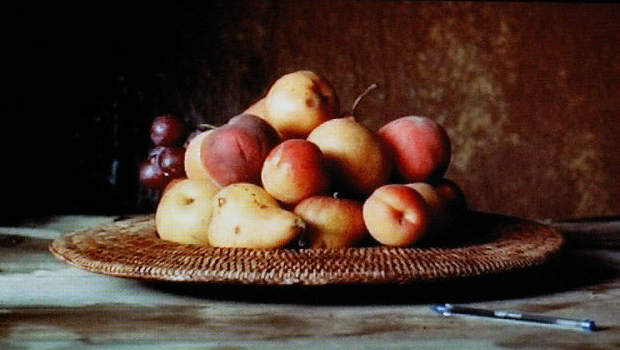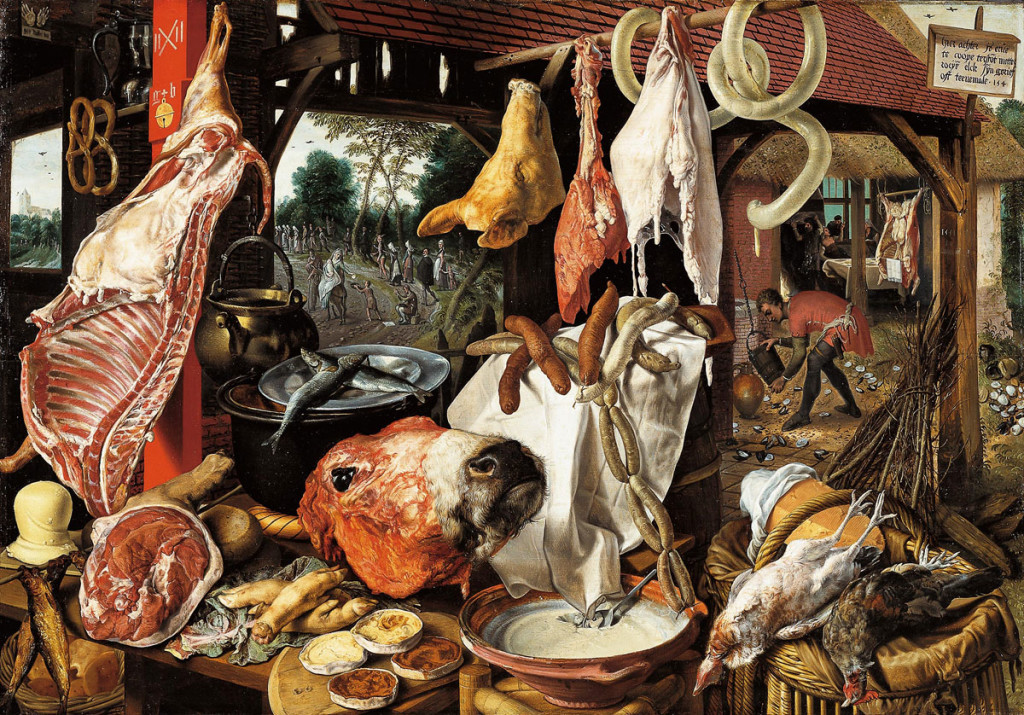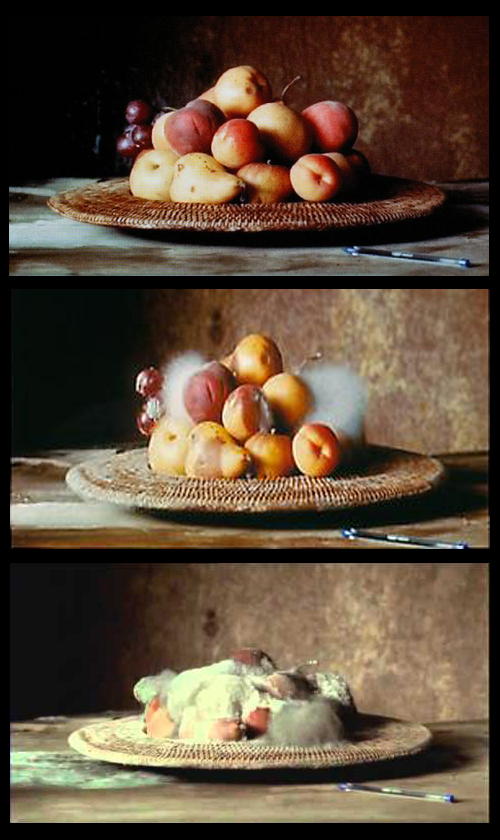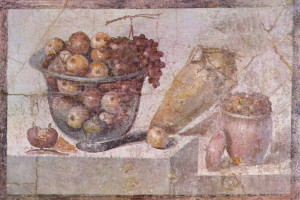
Still Life
Sam Taylor-Wood, British, 2001
(35mm film transferred to video)
Museum of Fine Arts, Boston
The next three entries are for the student who loves the history of art—in this case, the history of still life. Shall we begin?
Here we have a contemporary work of art, which looks exactly like still life paintings that were made hundreds of years ago. What comes to mind when you think of still life? Fruit? Flowers? Animal hunting trophies? Traditionally, a still life is a work of art that depicts commonplace objects such as food and flowers or man-made objects such as glasses, books, vases, or pipes. Over the centuries, many artists have enjoyed painting still life. Why do you think this is so? Artists who paint still life have more freedom in the arrangement of his or her composition than do artists who paint landscapes or portraits. When an artist paints a landscape, the weather may change right before his eyes. Equally so, when an artist paints a portrait, the sitter may have to attend to an itch and may shift his body around! Understandably, it is easier for an artist to experiment with the elements of art when painting objects that don’t move around or change quickly. It’s also easier for an artist when he or she has the freedom to move the objects around. In this way, an artist can control his composition and take the time to carefully study the relationship between color, line, and shape.
Before we look more closely at Sam Taylor-Wood’s Still Life in our third entry, let’s review the history of still life. Depictions of still life have a long tradition in the history of art. In ancient Egypt, images of offering tables piled high with foodstuffs were carved into the reliefs and false doors in the chapels of tombs and were painted onto the walls of tomb interiors. Why would the ancient Egyptians do this? The ancient Egyptians believed each and every person had a soul. They called this soul the ka. They believed that after a person died, his or her ka would travel between this world and the next and needed to be constantly fed. Representations of foodstuffs became stand-ins for the real things. It was believed these representations would provide one’s ka with sustenance in the afterlife. Thus, these objects were not symbolic of other things but were believed to embody real objects in and of themselves. What kinds of foodstuffs did the ancient Egyptians portray? They portrayed objects that were part of their normal diet, such as leeks and artichokes, ribs and legs of meat, ducks, cucumbers, and bread and beer. They also portrayed lilies, the fragrance of which was said to attract the opposite sex. Such images of still life were expected to provide the deceased with sustenance throughout all eternity.
The history of still life is first one in which artists strove to portray objects in a realistic manner. What do we mean by realistic? When there are many details and the details look real, we call art realistic. Many examples of realistic still life can be found depicted on the surfaces of ancient Greek vases. Although few ancient Greek paintings of still life have survived, according to one ancient Greek legend, an artist named Zeuxis depicted grapes in a painting that appeared so real it is said the birds flew down from the sky to peck at them. The tale of Zeuxis is an instructive one and well worth retelling. According to the tale, Zeuxis submitted his painting in a contest with another artist named Parrhasius. The objective of the contest was to determine which of the two was the greater artist. First, Zeuxis revealed his painting of grapes, and the birds mistook the painting for a bunch of real grapes. Next, Zeuxis asked Parrhasius to pull aside the curtain from his painting, only to find out that the curtain itself was a painting! Zeuxis was forced to admit defeat. He said, “I have deceived the birds, but Parrhasius has deceived Zeuxis!”
The tradition of painting in a realistic manner continued in ancient Rome. Wall paintings and floor mosaics were unearthed in Pompeii and Herculaneum that show realistic still life images. Many types of food are shown in these works. Such images were signs of hospitality and celebrations of the seasons and of the five senses. One common motif was of a glass bowl with fruit. Perhaps it was with the ancient Romans that still life objects began to take on greater and greater meaning. For example, ancient Roman artists would paint a skull as a symbol of mortality and earthly remains. Such vanitas images, as they are called, would be reinterpreted by European painters hundreds of years later. We will look at two of these vanitas paintings in our next entry. In the meantime, remember: the goal of artists was to create images so realistic, they would trick the eye of the viewer into believing they were the real thing.
Over time, the objects in a still life painting would become a symbol for others things and would convey a message or idea, oftentimes a religious one, as we see below in Aersten’s A Meat Stall with the Holy Family Giving Alms. Indeed, the still life objects in this Renaissance work are not only realistic, they are rich with symbolism. They are a feast for the mind as well as the eyes! Let’s first describe what we see. There are tables, wickerwork chairs and baskets, shiny metal plates and kettles, and a barrel, upon which there is a lavish display of meat and downy-feathered poultry, the bristly head of an oxen, pig’s trotters and head, a pair of fish, the cracked surface of cheese, soups and dangling chains of plump sausages. This realistic display of still life foodstuffs is contrasted with two smaller narrative scenes in the background. What is a narrative? A narrative is a scene that tells a story. These narrative scenes help to illustrate a message or idea. Before we address what the message or idea might be, let’s first describe the two narrative scenes. What narrative scene is on the right? There is a courtyard, in which a young man draws water from a well. Behind him hangs a slaughtered and gutted pig. Shells are strewn upon the ground near his feet. Beyond the courtyard is an inn and tavern where two couples are having a merry good time. This scene is contrasted with another scene on the left. Although it is difficult to see, a procession of worshipers approaches a church atop a hill. If you look carefully, you can see the church through a tiny opening of the stall on the upper left hand side. Focus your attention on the procession of worshipers. Among them is the Holy Family. Mary and the infant Jesus are riding a donkey, and Joseph is guiding them. Look carefully. What is Mary doing? She is offering bread to a boy and his father.

A Meat Stall with the Holy Family Giving Alms
Pieter Aertsen, Netherlandish, 1551
(oil on panel)
North Carolina Museum of Art
The objects and figures and action in Meat Stall are symbolic. In what way? The foodstuffs in the foreground are contrasted with the Holy Family in the background. Food for the body is linked with spiritual food for the soul. The bread offered by Mary to the boy and his father symbolizes the sacrifice of Jesus, who described himself as the “bread of life.” In addition, there is the crossed fish in the foreground, which is a traditional symbol of Jesus. Mary’s act of charity is contrasted with the figures in the tavern, who are probably eating too much and drinking too much and are generally misbehaving. The symbolic nature of the objects and figures and action in Meat Stall convey a message. What message might this be? Perhaps Aertsen is asking the viewer to consider his or her spiritual life. Perhaps he is asking the viewer to consider the consequences of indulging in earthly pleasures and to strive instead for the spiritual rewards to come.
Prior to Aertsen’s day (and for centuries afterward), the highest subject in art was the human figure in a religious or historical or mythological setting. When included, still life typically played a supporting role. Beginning with the work of artists like Aertsen, however, things started to change. The objects and figures in Aertsen’s Meat Stall have an inverted hierarchy, don’t they? This means the figures in the painting play a supporting role, while the still life objects play a leading role. After all, you can barely make out the figures in the background, while the still life objects in the foreground are bursting forth in an uproar of line and color and shape. Other artists would follow Aertsen’s lead and leave out figures all together, as we shall see in our next entry. But while still life came into its own as an art form in Western art, it continued to be considered a lowly art form and was for the most part symbolic.
If you are interested in learning more about the history of still life, be sure to read the next entry. There we will look at two vanitas still life paintings that are rich in symbolism.
§
Would you like to see Aertsen’s Meat Stall in person? All you have to do is visit the North Carolina Museum of Art in Raleigh, North Carolina. Aertsen’s Meat Stall is in the European galleries at the museum. Would you like to see Sam Taylor-Wood’s Still Life? All you have to do is visit the Museum of Fine Arts in Boston, Massachusetts. If you are interested in having a tour at either the North Carolina Museum of Art or the Museum of Fine Arts, check on-line or call ahead to find out the days and times tours are given to the public. Or perhaps you can contact either of these museums ahead of time and arrange for you and your friends to have a private tour. I’m sure a docent at either the North Carolina Museum of Art in Raleigh or the Museum of Fine Arts in Boston would be happy to show you and your friends the many wonderful works of art. Whether you visit these museums on your own or have a tour with a docent, it will be well worth your time!

